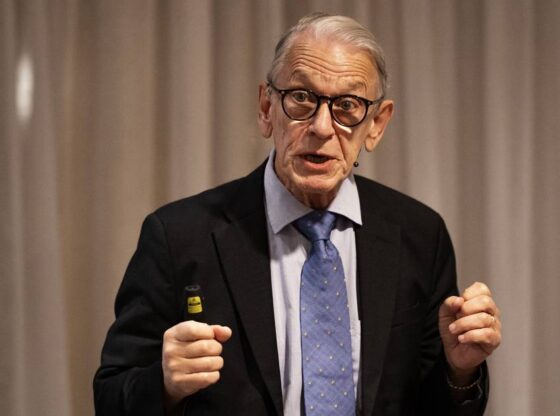Throughout his training, Urban Alehagen did not once hear about selenium. It was many years later, when wondering how he could prevent one of his patients from having another heart attack, that the Swedish cardiologist and university professor decided to conduct a study to understand whether selenium and coenzyme Q10 would have any impact in this regard. The answer was positive: not only can these two substances combined reduce the risk of death from heart disease, they can even prolong longevity.
These were the main conclusions that the cardiologist presented in last Thursday’s lecture – “Selenium and coenzyme Q10 in cardiovascular aging – Good news or fake news?” – and which demonstrate the benefits of selenium and coenzyme Q10 on our health. The results that prove this were obtained from a clinical investigation in which 443 Swedish elderly people participated, who, for four years, took 200 milligrams of coenzyme Q10 and selenium per day. Cardiovascular mortality reached just 6%, as opposed to 13% for those who received placebo.
“I couldn’t believe my own results. So we wanted to do a multivariate statistical analysis. We took into account being an old man, a smoker, with hypertension, diabetes, cardiac ischemia, heart failure and anemia, and even so, we had more than a 50% risk [de mortalidade] reduced”, said Urban Alehagen. After the intervention was interrupted, the participants were followed for another eight years and the same trend was observed.
After all, how much selenium is enough?
That is, without a doubt, the real question. When we talk about selenium, says Alehagen, the amount needed for our body’s cells to function well is approximately 120 micrograms per day. According to a study carried out in the United Kingdom, in 2019, more than half of the older population did not ingest 40 micrograms per day. This scenario is replicated in other countries in Northern Europe, including Sweden, Poland, Germany, Denmark and Belgium, and also in Southern Europe, Australia, New Zealand and South Africa. In the USA, there is no selenium deficiency.
This happens because agricultural soils in Europe are poor in selenium, which means that the foods from which we could obtain this mineral, such as bread and cereals (in addition to fish and meat), do not have enough selenium. “You may think that you just need to eat more meat to compensate for the low selenium intake. Yes, that is possible. However, they needed to eat a kilo and a half of meat every day”, explained the cardiologist, highlighting the importance of supplementation.
On the other hand, when it comes to coenzyme Q10, it begins to decrease drastically after the age of 20, which leads to a greater risk of developing certain diseases. Therefore, the benefits only reach the body when the levels of selenium and coenzyme Q10 are both balanced. And they are not just limited to diagnoses of heart disease, because, when combined, the substances can delay aging. There are positive impacts on inflammation and oxidative stress (directly related to aging), kidney function, prolongation of cell life and, ultimately, quality of life.
4 questions for Urban Alehagen
Is taking supplements an option to balance selenium and coenzyme Q10 levels? From what age?
To achieve good selenium levels, we would have to eat one and a half kilos of meat or fish every day, which is not practical at all. So, the only alternative is supplementation. This is the only choice if we want to have better health. As we were born in Europe, we are exposed to very little selenium, however, we have no scientific evidence that we can give selenium to children. I would be surprised if there were any negative results from it, but we don’t have any evidence, so I can’t tell my patients that they should give it to their children. We do have evidence that tells us that we should start taking it when we reach 20 and continue for the rest of our lives.
In addition to patients with cardiovascular diseases, can supplements have positive impacts on other diseases, such as cancer?
The problem with our study is that it is small. It’s one of the biggest on supplements, but we have 443 people and these people are healthy – studies in the cardiology field involve thousands of patients. We followed them for ten years and the number of people who had cancer was very small, but we can’t say anything for sure from this study. There is, however, a French study on prostate cancer that showed a very low incidence of prostate cancer when taking selenium. And we think it would make an even bigger difference if selenium was combined with coenzyme Q10.
Contrary to what happened before this study on selenium and coenzyme Q10 began, are there today more experts in the field, and even health organizations, more aware of this issue and talking about it?
Yes, but very slowly, too slowly. We have 30 published studies, so my colleagues are forced to accept that this may be true. There are starting to be other studies – there is one in the Netherlands and another in the United Kingdom. And it is clear that, only in this way, more and more colleagues in the area will be exposed to this evidence.
Can this revolutionize patients’ quality of life and help achieve healthy aging?
Revolutionize is a strong word, but what I am sure of is that this is the cheapest way to improve people’s health. It’s nothing compared to the cost of medicine, that’s important. The average quality of life will increase if we reduce the level of inflammation and we have accelerated inflammation due to the fact that we have low selenium.

